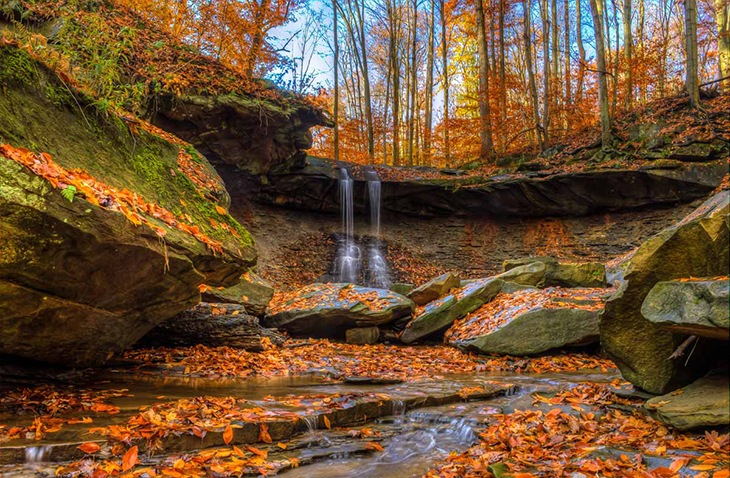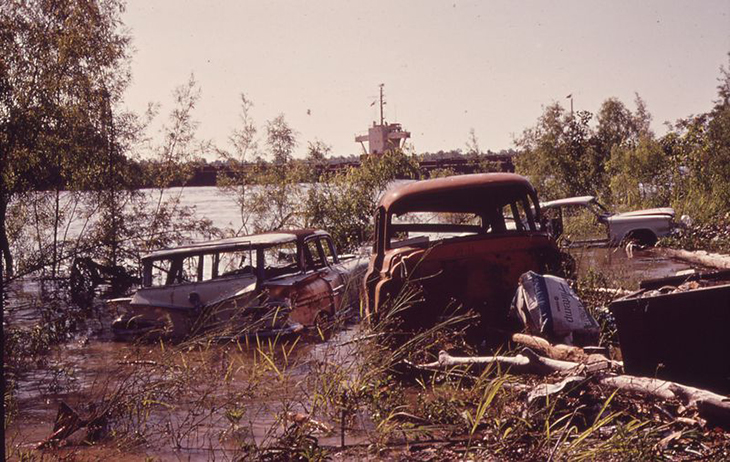
Can something beautiful come out from something nasty? With time, energy, money, and most importantly, dedication, the answer is a loud, resounding yes. What was once considered a dump has become one of the most beautiful places on earth.
The Cuyahoga National Park didn’t always look like the way it is. It was unsightly and unlivable. The place was ridden with toxic chemicals. It was also where people dumped their old, rusted cars. When you look at it now, you’ll be amazed at the difference.

President Gerald Ford decided to sign a bill that started the creation of Cuyahoga National Recreation Area in Ohio in 1974. Surrounding the site was a local garbage dump. They had assumed that this could easily be cleaned and cleared. They were very much mistaken. The park had been littered with waste and filled with toxic chemicals.
The National Park Service (NPS) had actually found out that it was a disarray because it had become a chemical wasteland. The water and soil there were so polluted that these were flammable. Cleaning it wouldn’t happen overnight. In fact, it took them decades, but the effort clearly paid off because they were able to convert it. The best part was that this was done at the polluters’ expense. Now, the park is a vital marsh ecosystem that is home to some of the highest biodiversity in the region.
Years back, thousands of rusted barrels that was filled with leaking and congealed industrial slime. Around it were a mix of pesticides, arsenic, paint, and heavy metals that were littered on the ground. You could see discarded tires as well, but now, these are gone. On the floor are peaceful forested ponds that are filled with fish, insects, and amphibians. You can also witness black-eyed Susans, New England asters, swamp milkweed, and foxglove, birds, bees, and butterflies that cover the borders of this vibrant ecosystem. It has become so clean that NPS staff, in fact, say you could eat the very dirt on its ground.
“This was a toxic wasteland only a few decades ago. To find this diversity of species there today is remarkable,” said Ecologist for Cuyahoga Valley National Park, Chris Davis.
The tragedy started when the Krejci (krech-ee) family opened up a dump along a river between Akron and Cleveland in 1940. This happened before municipal waste management even became an idea. The people in the area had been left responsible for their own waste disposal, and Krejci family unwittingly offered them a far-off place to do so.
The years had passed and the dumping continued. The 200-acre site, with 50 acres of being used as landfills, had started to accept heavier waste. In fact, most of the manufacturers from the Rust Belt had now depended on Krejci for disposal. Included here were harmful chemicals that no one wanted to touch.
Stuck with the Present Bill
Time had passed and the Cuyahoga had been slowly cleaned. It became a National Recreation Area. Then, eventually a national park. This is the only one of its kind found in the Rust Belt states. Unfortunately, it wasn’t as clean as they thought. Visitors began to get sick. The members of the NPS wanted to look into the situation and see why it had been so severe. They saw the problem and realized that the chemicals that once leaked in the area were still present. They then started a 25-year cleanup program.
As the leader for the cleanup, NPS needed money for this somewhat expensive project. They nominated Shawn Mulligan, a former Assistant Attorney General for Colorado, as an attorney that represented their group. Mulligan would go after big companies such as Chevron, Ford, Federal Metal Co., and Chrysler for the price of $50 million accrued for damages. These conglomerates had to pay for what they destroyed.
“It was unfair to the American public to bear all these costs,” Mulligan said when he spoke to NPS magazine. “The National Park Service should not contain sacrifice zones. Every parcel of property is held in the public trust, and we have a responsibility to do everything we can to protect and preserve that resource.”
The case wasn’t quick. In fact, it dragged on. In the process, a few of the EPA legal staff believed that they’d see good results on their side. Eventually, as the NPS reported in a 2016 magazine issue, the Ford company talked to the NPS legal team. They came up with a solution, and it was to let the Motor City mechanics pay for and organize the entire cleanup process.
And So It Begins
NPS nominated Veronica Dickerson for this. She was the environmental protection and safety manager for Cuyahoga Valley National Park. They wanted her to assist in overseeing the project.
“To get assigned to it, you’re like a little kid getting a Christmas present,” Dickerson said when he spike to ABC news Cleveland the previous year. “It was amazing to… start to work on this project and see it through completion.”
However, it wouldn’t be easy. Burying the toxic waste that had accumulated over time posed a serious hazard to the people involved. The toxic components had already infested the water table, soil, and all the other areas that went beyond the end of the park’s fences.
It was a good thing that Ford had offices and resources to offer. They hired contractors who needed to excavate the contaminated soils. As they dig deeper, they saw an accumulation of sludge and more dangerous carcinogens such as polychlorinated biphenyls, or polyaromatic hydrocarbons.
Still, the pursued and they got rid of the rusted cars and barrels, tires, and other kinds of waste and old machinery. The clearing out took place from 2002 to 2012. They also got rid of 400,000 tons of contaminated dirt. This is actually tantamount to around 20 feet worth of topsoil.
Once the barrels were completely cleared and the soil samples had been devoid of containments, the men contoured the ground in order to match the ecosystem around it. They also built several wetlands on the 50-acre dumping site.
How Krejci Dump is Now
The work had truly paid off because today, they site is filled with indigenous plants. It has become the natural wetlands where a variety of plant and animal species live and thrive.
Park visitors now come to visit the area and take photos of the beautiful surroundings. They get to experience the full-summer landscape in the midst of a growth of native wildflowers and grasses. They can enjoy sites of turtles sunning themselves as they perch on floating logs. And if they listened intently, they could hear birds sing atop of trees.
Ford has done its part as well. The people behind the company have been involved every step of the way. They have paid their debt to society and shelled out a total of $29 million for it. Still, they work to see that the grasses and vegetation grow undisturbed to this very day. They also make sure that soil erosion never takes place in the now pristine lad.
“[The Krejci site] is now as clean as any natural area in the park,” Dickerson said. “That’s something remarkable, considering what it was in 1985.”
He also added, “You can categorize wetlands and these are right up there with a three and a four (the top rating for wetlands). They can sustain high levels of benthic communities and critters and turtles. They can sustain life here. It’s a vibrant resource for them.”
What are your thoughts? Please comment below and share this news!
True Activist / Report a typo


